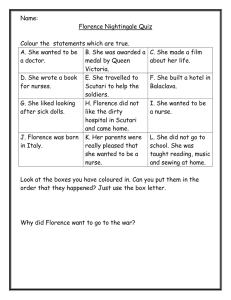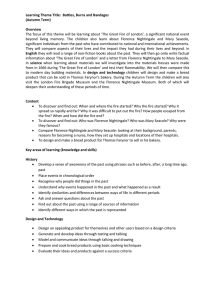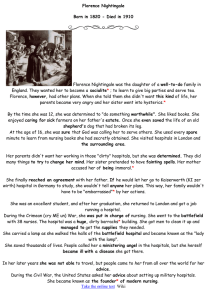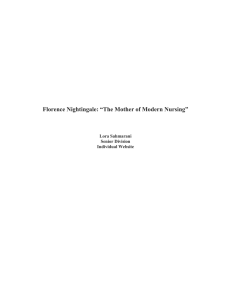History: Florence Nightingale ...
advertisement
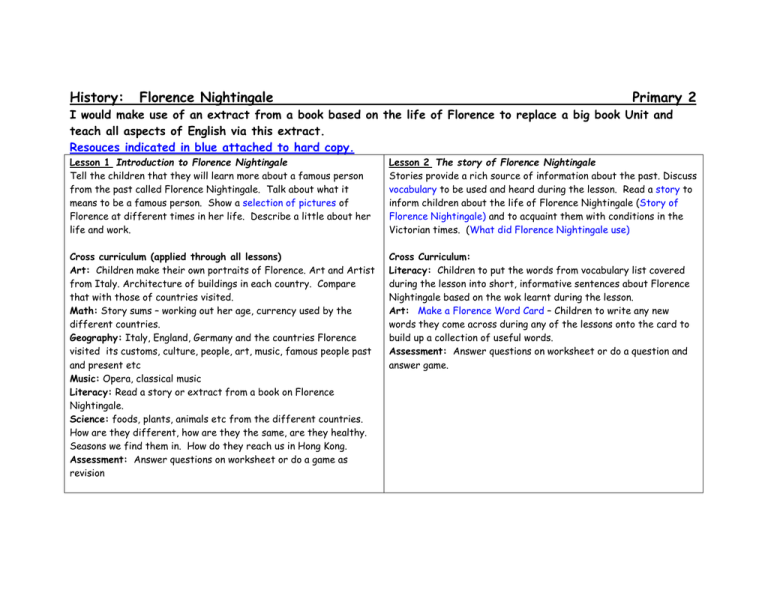
History: Florence Nightingale Primary 2 I would make use of an extract from a book based on the life of Florence to replace a big book Unit and teach all aspects of English via this extract. Resouces indicated in blue attached to hard copy. Lesson 1 Introduction to Florence Nightingale Tell the children that they will learn more about a famous person from the past called Florence Nightingale. Talk about what it means to be a famous person. Show a selection of pictures of Florence at different times in her life. Describe a little about her life and work. Lesson 2 The story of Florence Nightingale Stories provide a rich source of information about the past. Discuss vocabulary to be used and heard during the lesson. Read a story to inform children about the life of Florence Nightingale (Story of Florence Nightingale) and to acquaint them with conditions in the Victorian times. (What did Florence Nightingale use) Cross curriculum (applied through all lessons) Art: Children make their own portraits of Florence. Art and Artist from Italy. Architecture of buildings in each country. Compare that with those of countries visited. Math: Story sums – working out her age, currency used by the different countries. Geography: Italy, England, Germany and the countries Florence visited its customs, culture, people, art, music, famous people past and present etc Music: Opera, classical music Literacy: Read a story or extract from a book on Florence Nightingale. Science: foods, plants, animals etc from the different countries. How are they different, how are they the same, are they healthy. Seasons we find them in. How do they reach us in Hong Kong. Assessment: Answer questions on worksheet or do a game as revision Cross Curriculum: Literacy: Children to put the words from vocabulary list covered during the lesson into short, informative sentences about Florence Nightingale based on the wok learnt during the lesson. Art: Make a Florence Word Card – Children to write any new words they come across during any of the lessons onto the card to build up a collection of useful words. Assessment: Answer questions on worksheet or do a question and answer game. Lesson 3 What is being a nurse like? Children to learn about the past by comparing features of past life with modern equivalents. By looking at a modern nurse, children will fully understand the role of Florence Nightingale, as well as being to see how working as a nurse has changed over time. Make use of pictures of Florence Nightingale during her time as a nurse. Compare these with pictures of nurses of today. Work out a set of questions to be discussed around the pictures. Discuss objects used by Florence during her times and how they differ from those used today. Cross Curriculum Literacy: Shared writing – children to list similarities and differences under the headings of Same and Different. Make a list of all the equipment used during the time of Florence Nightingale. Commas and lists. Assessment: Check shared writing for correct information. Lesson 4 Where is Crimea? Making use of a map – children to indicate where Hong Kong is. Britain in relation to Hong Kong. Crimea in relation to Britain and Hong Kong. Talk about the different means of travel available in those days. Make use of “A route to the Crimea” showing the main places on Florence Nightingale’s journey. Give a background to the Crimean War. Cross Curriculum Geography: How to read the key on a map, how to read a compass. Crimea today known as the Ukraine, making use of maps. Art: Draw a compass and show the different directions Literacy: Write new words on Florence new words cards. Children find out about the past through role play and drama. Assessment: Children to colour a map indicating places she went to. Lesson 5 Listening to Florence speaking Listen to the recording of Florence speaking. We can hear her voice, Find on www.bl.uk/collections/sound-archive/history.html. Show enlarged copies of the words she is saying. Ask the children to listen to the sound of the recording. How do we know it was made many years ago? Discuss how this way of talking seems old fashioned to us now. Pick out words and phrases that we would not use when we are talking today. Cross Curriculum: Music and Art: Re-enacting key scenes from the life of Florence Nightingale through drama and song. Literacy: Conducting an interview with Florence Nightingale. Assessment: Complete worksheet making use of past words and what they are known as today. Lesson 6 Two Nurses Explain to the children that they are going to hear two nurses accounts of what it was like at Scutari. Explain that it will give them an understanding of what it was like at Scutari from someone other than Florence Nightingale. The accounts of an anonymous St John’s nurse and that of Mary Ann Coyle, another St John’s nurse. Cross Curriculum: Literacy: shared writing: Create a story about life at Scutari from the point of view of Florence Nightingale. Music, Art, Drama and role play. Communicate their learning about hospitals and learning through role play Diary time: Write about the day in the life of Florence Nightingale as a nurse. Assessment: Complete a worksheet based on the accounts of the two nurses. Lesson 7 Sequencing events in Florence Nightingale’s life. Read and share the simple version of the story of Florence Nightingale’s life with the class. Make use of pictures to illustrate various scenes from her life, have separate sentence cards of key events from the story of Florence Nightingale’s life. Arrange the children in small groups. Give each group a set of cards with the sentences on arranged in the wrong order. Children to read the sentences through and support them where necessary. Children to sequence the main events from the story. When the groups are satisfied with their sequences help them to check their sentences. Cross Curriculum Art: Draw a story sequence or a set of pictures to tell the story of Florence Nightingale. Assessment: Correct sequencing of events. Lesson 8 People alive at the same time as Florence Nightingale. Queen Victoria – queen of England at the time. Einstein – Law of relativity. Sacajawea - Shoshone woman who accompanied the Lewis and Clark Expeditions. Loop in later when Literacy Unit including Helen Keller is done towards the end of the year. Enabling one to draw all work of the year together to conclude with fun ways of revision. Decorations on class room walls could be used. Mary Seacole – nurse during the time of Florence Edison - globe Joan Frances Champolion – first westerner to decipher the hieroglyphics. Alaxander Graham Bell - telephone Helen Keller – paved the way for blind and deaf people Braille – system for blind people to read. Background on each person provided Cross Curriculum Geography: England, America, Germany, France, Egypt, India and Africa due to links with Egypt and native tribes. Flags of the different countries Art: Wheels and the wheel of life symbolism use on many countries flags. History: Historical figures past and present of countries chosen to work on. Music: Look at the different types of music, instruments etc past and present of each country. Lesson 9 Continue with lesson 8 People alive at the same time as Florence Nightingale Lesson 10 Assembly on Florence Nightingale. P2 Communicate their knowledge of Florence Nightingale to the rest of the school at assembly using work produced over the past 7 lessons. Preparation. Select props for the assembly. Group the children to work on their presentations of different aspects of their work. a brief biography of Florence’s life. Pictures and paintings of Florence’s life. Pictures of the hospital where she and her nurses worked. Stories from the nurses who worked with her. Two children to introduce the sound recording of Florence. People alive at the same time as Florence Nightingale. Children can hold pictures up of their work and say a few words about it in turn. Those with stories can read them out to the audience. Lesson 11 Who was Mary Seacole Tell the children that they are going to learn about another famous person from long ago and that she is called Mary Seacole. Make use of a selection of pictures and maps to tell the children more about Mary Seacole. Tell the story of Mary Seacole and display her information and the children’s work next to that of Florence Nightingale. Cross Curriculum: Geography: Jamaica Music: Listen to music from Jamaica, discuss the tempo, rhythm and instruments used. How is it different from the music of Italy. Architecture of buildings and compare that with the other countries visited. Lesson 12 Mary Seacole and her adventures through her Autobiography. Tell the children how Mary Seacole decided to go to the front line to help wounded soldiers. How she built a “British Hotel’ which began as a general store. Discuss the meaning of front line. Explain that we learn a lot about Mary and her life through information in her autobiography. The Wonderful Adventures of Mrs Seacole in Many Lands. It is a non-fiction book. Non fiction text on Mary Seacole. Explain the meaning of an autobiography. What is a non-fiction book? Read the extract written by Mary Seacole herself. Cross Curriculum: Literacy: write new words on Mary New Word Card. Write a sentence and give a description of a fiction and non fiction book. What does an illustrator do? Assessment: Complete Quizz sheet base on Mary Seacole.
